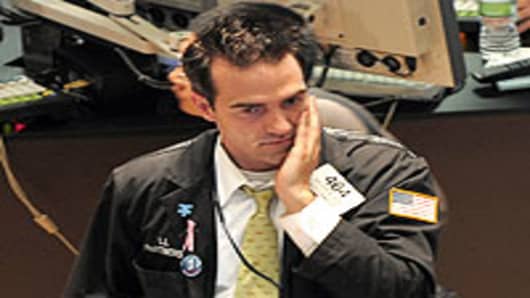For the first time in at least eight months, investors are not treating the latest stock downturn as a buy-the-dips opportunity.
Instead, intensifying fears about sovereign debt—and the stability of the European Union itself—that has triggered a belief that the US dollar will rise in value is chasing money into much safer places.
"I'm pretty convinced that Greece is basically going to have to withdraw from the European Union," says Michael Cohn, chief market strategist at Global Arena Investment Management in New York. "So it's just like Bear Stearns: Who's going to be next? Is it going to be Spain? Ireland? That's going to hit the market pretty bad. It's going to be like a perceived domino effect."
Greece's problems stem from the looming reality that it will not be able to afford to finance its own debt.
Should that happen, the nation will be left with two alternatives: Either restructure the debt, or try to inflate its way out of the crisis by devaluing its currency. However, Greece is prohibited from doing so as a member of the EU, which uses the euro as a joint regional currency.
The notion that the escalation of the Greek debt crisis will spread throughout the continent and eventually make its way to the US has investors more than a little jittery.
"We're still in the same boat where we see see these macro problems," says Kathy Boyle, president of Chapin Hill Advisors in New York. "The whole environment is much more fragile."
Boyle sees danger signs in commodities, which have wobbled lately as the dollar has strengthened. Commodities and stocks have been moving in the same direction, so any weakness might pose an additional danger.
"The question is, do we get another rally or are we straight down?" she says. "The bottom line is by September we're a lot lower than we are now."
Investors have left risk assets like stocks and have turned to the dollar and Treasurys for protection. The major stock averageshave lost more than 3 percent each since early May, while smaller stocks, as measured by the Russell 2000, have dropped nearly 5 percent in the same span.
Small- and mid-caps had strongly outperformed the broader market since the latest rally that began in late August 2010, and in fact over the past 10 years. So their poor performance this month was being looked at as a possible paradigm shift in market sentiment.
"We think that one of the reasons why small and mid cap beat large cap for so much of the past decade was that while mutual fund dollars were rotating from US equities to bonds and international funds, that the main funding source was US large cap funds," Credit Suisse analyst Lori Calvasina wrote in a note to clients. "These trends may be starting to reverse."
"Coupled with our concerns about stretched valuations versus large caps, and slowing profitability growth, these shifting money flow trends add to our concern that small/mid caps are due for a bout of underperformance vs. large caps," she added.
The shift to larger caps, and in particular dividend-paying stocks, has become a prevalent theme from the larger investment houses.
In a climate of uncertainty, portfolio managers have been hunting for yield. Corporate bonds had been a popular place for that strategy. But with dwindling yields even for junk bonds, dividends have become a more popular theme.
Some are going even a step further and heading for cash. Money market funds are holding $2.74 trillion, about in line with the average for 2011 but a number that could be headed higher if investor sentiment polls can be trusted.
The latest numbers from the American Association of Individual Investorshave the bull-bear spread at 26.7 to 41.3 percent, the lowest for the bulls and the highest for the bears since the rally began late last summer.
"I'm playing it pretty safe these just, just raising a lot of cash," Cohn says. "Hopefully (a major drop) doesn't happen. If it does happen I can buy stuff on the cheap."
Boyle says that investors who head for defensive sectors, like health care and consumer staples, are reducing but not eliminating losses from a broader market decline. Instead, she uses inverse exchange-traded funds, which reward market losses, as strategy to capitalize on a downturn.
Still, based on current price-to-earnings ratios in the 13 to 14 range, history would suggest that a full-blown bear market drop of 20 percent is unlikely.
Sam Stovall, chief equity strategist at Standard & Poor's, says seven of the 10 S&P 500 sectors are trading at P/E values below their medians since 1994, when the firm began tracking sector earnings. Energy, financials and information technology are the sectors above those levels, suggesting the other seven sectors are still well-priced.
"A stock market pullback or correction is always a possibility, but not so a new bear market, in our view," Stovall said in a research note for clients. "Should our economic and EPS projections hold up, we will likely find that this current weakness was another buying opportunity."
However, he adds, in a statement that seems to reflect the market's intense unease, that should the economy fail to live up to recovery expectations, the impact on the markets could be severe.
"We have to respect the market's ability to project changes in economic distortions and speeds approximately six months down the road," Stovall wrote. "So should this recent share price weakness persist, we need to acknowledge the possibility of an economic soft patch (or worse) and its ominous impact on the global equity markets."



